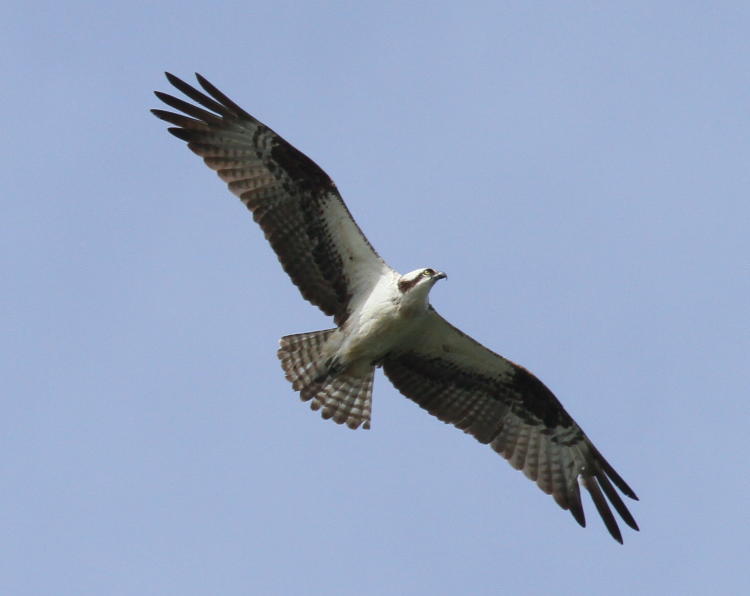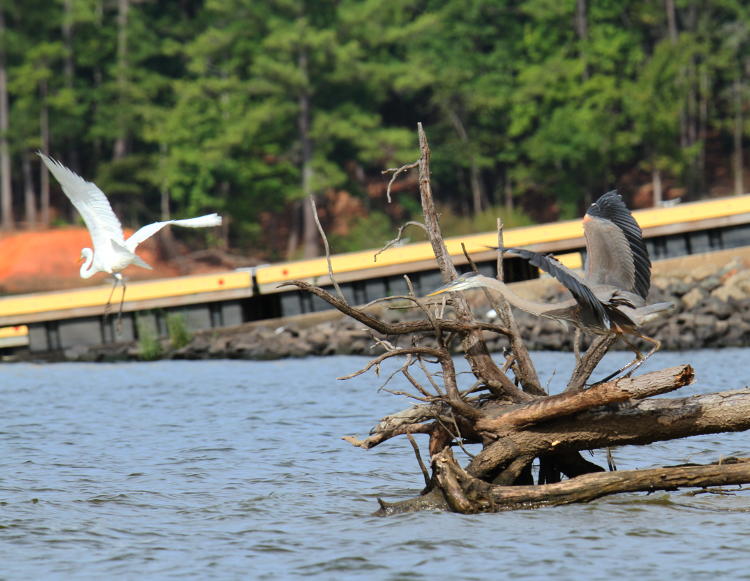Later in the morning yesterday – much later than I should’ve – I decided to take a quick trip down to Jordan Lake, see if there was anything happening down there. I had no intentions of spending a lot of time, and in fact was planning to meet someone for lunch, so, whatever I could find in 90 minutes or less (or it’s free!)
Not too shabby, for all that.

I feel like I need to keep reminding people (dunno why,) but nature photography is very unpredictable; even if you know the habits and habitats of any given target species, even if you plan meticulously, you can see nothing worthwhile for your efforts. Or you may just snag a few good frames with only trivial preparation. A flight of turkey vultures was wheeling overhead, taking advantage of a small thermal (rising warm air mass) on the edge of the lake, but among them, slightly higher in altitude, were a pair of osprey (Pandion haliaetus.) As I watched, they converged in banks briefly, and I was already backing off the focal length to get them both in the frame.
But that’s too small to see detail, so we’ll go in tighter on that one on the right.

The day was a bit hazy, with a largely boring, colorless sky, but I got lucky with the timing on this one and had a bit of blue to work with, while the sun remained low enough to get some acceptable lighting on them as they banked. Early and late sunlight hours are almost always better for the birds, since the birds are most active then, as well as providing light angles that work for our vantage underneath.
A great egret (Ardea alba) cruised in and landed nearby, but stayed in a cluttered region that sucked for photos, then flew a little ways away when I tried to creep over to a better vantage. But, this allowed me to get better angles.

This is a fairly tight crop, because the suspicious expression comes through better this way. It would be easy to believe that I was the target of this look, but I was quite a distance away, farther than when it had first landed, plus it wasn’t staring, but examining the area. Impressions can be misleading, even if fun.
Soon afterward, a great blue heron (Ardea herodias) revealed itself in the immediate vicinity, and since I didn’t see it fly in, I am presuming that it was very close by but hidden. That’s it over on the left, trying to look like a stick (and you can see how well their coloration works now.)

Now you know why the previous tighter crop worked better, because there was nothing I could do about that boat ramp in the background. It might have been better had it not been painted bright yellow, but I guess someone thinks boaters should be able to find it in foggy conditions or something. Very typical: no consideration of the nature photographers at all.
For a few minutes, it appeared that the two species were quite fine sharing the spot, but this was, again, the wrong impression.

By the way, a word about photography habits. While I might give the impression here that I was closely observing their behavior the entire time, in truth I’d watched for any initial drama, fishing behavior, or good poses, then turned my attention elsewhere. The big lens is too heavy to maintain ‘on target’ for long, plus the narrow field of view means you might miss something happening just outside the frame. Not to mention that I was still looking for more interesting shots, perhaps overhead, perhaps out over the open lake more. So I had to hastily re-aim when I heard the warning croak of the great blue – but I still had exposure compensation on for the brighter sky shots that I was taking in the interim. Thus this frame was mildly overexposed, and has been darkened in post. I’m not happy about all the clutter around the great blue, and if I’d been quicker might have had a better composition a moment earlier, but whatcha gonna do?
Because, keeping my eyes open and watching the entire area for activity netted me the frames that I was happiest to get for the day.

This is what a juvenile bald eagle (Haliaeetus leucocephalus) looks like – kinda. I mean, it’s one phase; their appearance differs from year to year until their fourth, when they take on the classic adult coloration that we all recognize. Except, this looks like a mix between second and third year plumage, with some indications that it’s in the process of molting. So, someone else can fill in the pertinent details.
By the way, this one has been lightened in post, since I spotted the eagle as it was passing close to the sun (because I’m alert as hell, boyo,) and even though I had exposure compensation dialed in for shooting into the sky, it wasn’t set for shooting the sun, so the eagle was more silhouetted than seen here – I just brightened the darker areas and left the sky alone. And I was glad I listened to that inner voice that told me something was different, because the eagle appeared not far from the vultures. There are some subtle differences in silhouette/body shape, but more distinctly, they have different flapping patterns; vultures tend to flap to gain altitude, but otherwise glide as much as possible, while eagles are more constant flappers, gliding in patches.
Another pic in closing, for the detail.

Actually, I just liked seeing those talons tucked up in there, and the fact that it never seemed to close its mouth. Allergies, man – I can relate.



















































